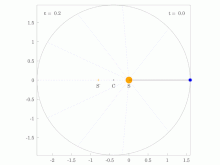Diskuto:Leĝoj de Kepler
La esprimoj "leĝo Kepler" kaj "leĝo Newton" estas certe ĝustaj laŭ la gramatiko de Esperanto. Tamen ili estas laŭ mia impreso iom nekutimaj. Francoj sendube tuj komprenas ilin, ne-eŭropanoj eble preferus la esprimojn "leĝo de Kepler" kaj "leĝo de Newton". -- Umberto 20:09, 18. Jul 2005 (UTC)
Tute malĝusta titolo. Kial ne Kepleraj leĝoj aŭ Tri leĝoj de Kepler'(o). Movado por rivoluo, moviĝo de la planedoj? Narvalo 06:10, 19. Jul 2005 (UTC)
Jes "Kepleraj leĝoj" estas pli Esperant-maniera. (Eliott)
You can translate it e.g. with the Inkscape: Dosiero:Kepler-first-law.svg -- hu:User:Harp
Animations demonstrating Kepler's Second Law of Planetary Motion.[redakti fonton]
There is an animated figure on the English version of this page which I made which the shows motion of planets orbiting with various eccentricities around a star and may be of use.
The animated gifs are individually viewable at
https://commons.wikimedia.org/wiki/File:Circular_orbit_of_planet_with_(eccentricty_of_0.0).gif https://commons.wikimedia.org/wiki/File:Ellipitical_orbit_of_planet_with_an_eccentricty_of_0.2.gif https://commons.wikimedia.org/wiki/File:Ellipitical_orbit_of_planet_with_an_eccentricty_of_0.5.gif https://commons.wikimedia.org/wiki/File:Ellipitical_orbit_of_planet_with_an_eccentricty_of_0.8.gif
The code to produce the table is here (see edit mode):





